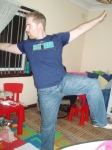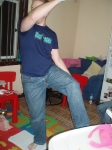Wii Fit and amputees – first impressions!
Akin to what I was nerding about in my earlier post, below is my awesome review/first impressions of Wii Fit!
For those unaware what Wii Fit is, check out the Wikipedia entry – it’ll make more sense than my crazy ramblings in trying to describe it. Probably more informative too 🙂 To quickly summarise to add some context though, Wii Fit is a game on the Nintendo Wii (aka Nintendo’s money-printing machine) that aims to have you do daily exercises instructed on-screen by standing on a board that wirelessly communicates with the Wii console. Fancy and ingenious piece of kit, much like the Wii in general to be honest. Wifey and I don’t have a Wii ourselves, but we recently caught up with my brother and his family and they’ve got one, so it proved the perfect opportunity to demonstrate my extreme awesomeness. It also gave me the opportunity to give an amputee’s view on how it works.
After doing my initial data entry to get the ball rolling, it appeared there were going to be some skewed results in one of the main tests you go through when you start up your session on Wii Fit, as there are all sorts of balance tests. It tests and works your center of balance, and how you hold your balance according to your right/left side of the body. Not surprisingly, it confirmed my feeling that my center of balance is slightly behind me, and a little to the right in lieu of having one leg. Things really got interesting when it got me to do the one-legged balancing tests though!
Now, this was all well and good on my right leg, given I have one! But what to do when the tests come up for the left leg?
Simple, cheat and use your right leg, but ensure you look like a doofus while doing so:
As you can see from the results in the image below, it took a little bit to adjust to the balance board!! Those squiggles indicate my shift in balance over the course of time it tracked me standing on each side… ideally there should be very little variation 😛
🙂
And from here, things kept getting better – the trainer decided to offer his evaluation on the situation following my results:
lol!
You know, because I totally have a left leg 😉 By the time I got to the second leg I reckon I had gotten the hang a little better in using the balance board, hence the result (remember that I used my right leg when doing the tests for the left leg!). Still, gotta love some canned advice from a computer program 🙂
Once the tests and BMI, etc, were all finished (for those interested, my first Wii Fit age was 11 years older than me; when I gave it a crack a few days later, I managed to bring it down to only 2 years older than my actual age — hurrah!), I thought I’d have a quick go at some of the activities. I can’t remember off the top of my head which ones I did – I had a look at the yoga ones but passed, as it looked too tricky to work my way around them and find a solution given I was in a bit of a silly mood when playing the game. I gave the hooly-hoops a whirl, but that didn’t work that well either (was apparently funny to watch though ;)). I ended up settling on the muscle workouts, specifically the pushups one.
I mean, c’mon – I can do pushups, whether it be on my hands, knuckles, dive-bomber and with/without my leg on. So I figured I’d be right; turns out there was a twist with what was to come!
Now, before I get started, I’d like to share this cracker of a screenshot:
While I’m sure Nintendo means well, I think a “skip” button on these would be helpful since I notice he has all his limbs intact 🙂
Anywho, so onto the pushup – aside from the trainer going infuriatingly slow, he then starts adding in these twists at the ends of each of his motions! Now, this is all well and good if you’re coordinated and have two legs – makes it tricky as an amputee though, as there’s no way to elegantly rotate your body without striking awesome/stupid poses for the people sharing the experience with you in the same room (Wifey was crying from laughing so much as I pulled the most ridiculous poses in trying to keep up with the instructions!):
Now, with all this being said, you might think I’m being overly harsh with the game – I mean, did Nintendo deliberately go out of their way to alienate disabled people with this game? Of course not. And do I harbour I strong dislike of the game? Absolutely not – it was a blast to play, but it certainly represents a number of challenges to those of us missing a few key limbs to make the experience complete.
Playing the physical games like Wii Fit can be a lot of fun, but there’s also the issue that, when playing socially, it can be a bit alienating depending on how good you are with your prosthesis – I was in excellent company so I had a ball sharing my goofiness, but at the end of the day it makes it very hard to keep up with people who are generally more physically able than an amputee. It’s kind of like Dance Dance Revolution – several years back I used to really like playing it, but the most I could ever get to was… either Beginner or Easy/whatever it’s called – I just couldn’t keep up with enough consistency if the difficulty was any higher, which was a bummer, because I couldn’t physically move around fast enough due to the prosthesis.
But getting back to Wii Fit, I have a feeling there are probably a handful of tricks I could uncover to bridge the gap between amputees and able-bodied players, but in the short time I had playing it, there certainly wasn’t enough time to really dig in and uncover the possibilities and post up straight away to share. Wifey and I are looking at grabbing a Wii with Wii Fit some time later this year (not sure when at this stage, maybe closer to x-mas when there are usually some good bundles/packages available at retail), so I’ll be happy to share some strategies and possibly write up an FAQ then. I think the game has a lot of promise and reckon there’s potential tricks so that amputees can possibly keep up with able-bodied people to some degree, but I won’t know until I have the opportunity to give it as more extensive whirl.
Mind, I’d post my thoughts up sooner if Nintendo Australia is kind enough to gift a Wii and Wi Fit for my household 🙂
… what, can’t blame a guy for trying, can you? 😀
If you want to check out more pics of me making an arse of myself, I’ve added a dedicated Wii Fit 2009 gallery under (funnily enough!) the ‘Gallery’ menu on the top nav bar; alternatively, you can also click here to access it. Huge thanks to Wifey for being a good sport and taking the photos, and to my brother and his family for treating us to some Wii Fit gamage that night 😀 We hada ball, and I can’t wait to catch up again to give it another go!!!











